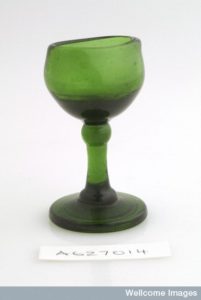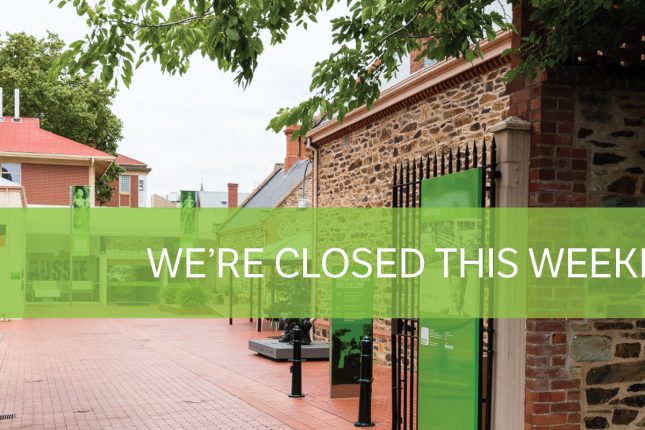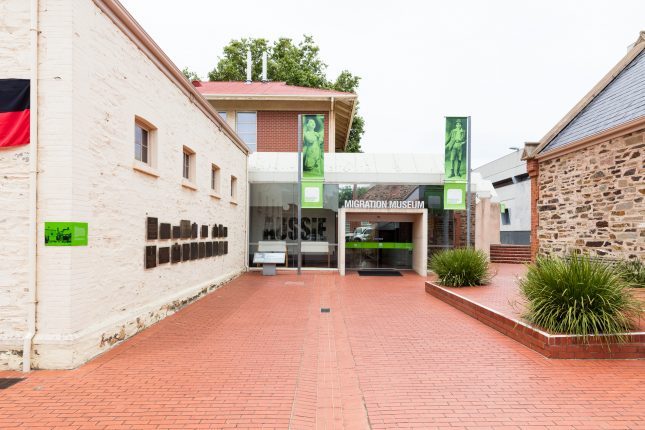Seeing clearly at the Destitute Asylum – an eyebath
Written by Corinne Ball | September 20th, 2016
In 1983, before the Migration Museum opened, an archaeological dig was undertaken on the Kintore Avenue site in an attempt to salvage some of the last material available from the old Destitute Asylum. One of the fragments uncovered was a tiny glass cup reminiscent of a wine glass – a nineteenth century eyebath.
The Lying-in Home and Mothers’ Wards which form the current Migration Museum are the last remaining buildings of what was once a much larger complex. At its height in the 1880s the Destitute Asylum occupied the area upon which now stand the State Library, Artlab, SA Museum Science Centre, and the Hartley, Madley and Schulz buildings of Adelaide University. After the last residents left the Destitute Asylum in 1918 these northern and eastern sections were gradually demolished and no trace remained after the 1960s.
During the 1983 dig several small objects such as tobacco pipes, inkwells and even two women’s boots were recovered, as well as numerous fragments of medicine bottles, glass-wear and household ceramics. The larger of these were catalogued and added to our museum collection, and some are currently on display in our exhibition ‘In this place: a history of the Migration Museum site’. Many of the smaller fragments were placed into storage, and it is in this trove of uncatalogued, hidden treasures that we recently discovered this small eyebath.
Eyebaths are used to flush out an eye with water or a medicinal liquid, and plastic baths are still used today. In the nineteenth century eyebaths were made of green, blue or clear glass, ceramic or even of silver. Their curved sides are designed to fit neatly into the eye socket, allowing liquid to wash the eye without spilling.
Ophthalmia or ‘blight’, a painful and recurrent eye infection which today is easily treated with antibiotics, was rife in care institutions in the nineteenth and early twentieth centuries. We know from research undertaken for ‘In this place’ that many people who passed through the Destitute Asylum system suffered from blight, and in 1888 the Destitute Board was urged to create a separate ophthalmia ward at the Destitute Asylum to prevent further spread of the disease.
Popular treatments for ophthalmia involved bathing the eye with solutions of zinc sulphate or silver nitrate, but these were unable to completely cure the disease, and many people’s eyesight was permanently affected. In severe cases the infection could cause blindness. Annie Hargraves, one of the children featured in our exhibition, was returned to the Destitute Board by several foster placements because her recurrent ophthalmia prevented her from working. Annie’s condition was so chronic that she remained in State care two full years longer than the regular term for a young woman – she was eventually released on her 20th birthday.
It is sobering to think that this little fragment of glass tells such a painful story of life in the Destitute Asylum. But it is also heartening that these snippets of material culture, buried for decades, can really connect us to people in the past.
Migration Museum collection HT 2016.53, courtesy Flinders University Archeology Department, 1983
THE DESTITUTE ASYLUM. (1888, December 12). Evening Journal (Adelaide, SA : 1869 – 1912), p. 4 (SECOND EDITION).
http://nla.gov.au/nla.news-article204466716

Eyebath in Wellcome Collection, UK


 Show all
Show all Read this post
Read this post

 Visit
Visit